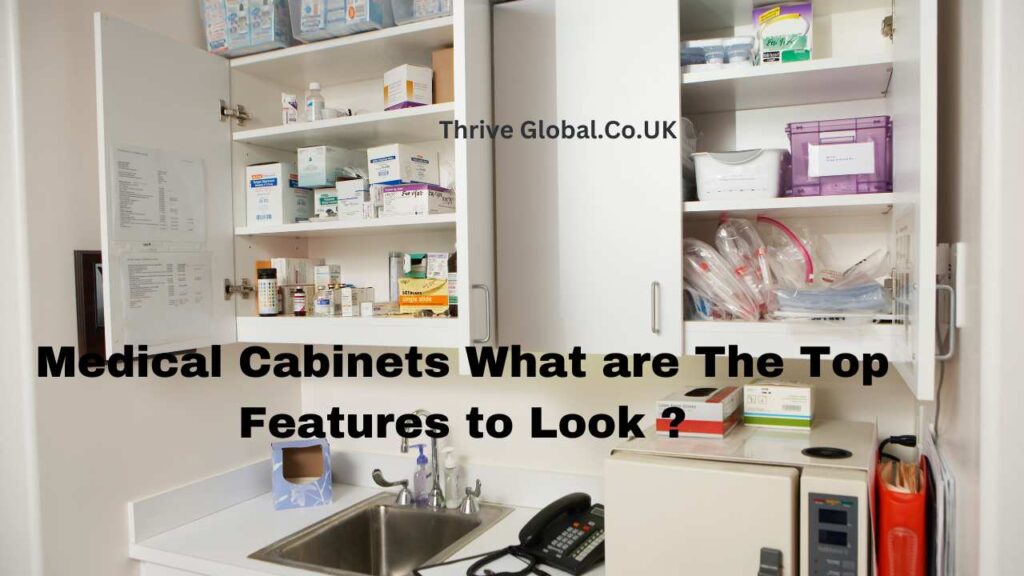When setting up a healthcare facility, one of the most crucial elements to consider is the medical cabinets. These storage units play a vital role in organizing medical supplies, ensuring safety, and maintaining hygiene standards. But with so many options available, what features should you prioritize? So what are the top features to look for in medical cabinets to make the best choice for your healthcare setting.
Types of Medical Cabinets
Choosing the right type of medical cabinet depends on your specific needs and space constraints. Here are the main types to consider:
Wall-Mounted Cabinets
Wall-mounted cabinets are perfect for saving floor space. They can be installed at various heights, making them accessible and ideal for smaller rooms where every inch counts. These cabinets are typically used for storing lighter items that need to be easily reachable.
Freestanding Cabinets
Freestanding cabinets offer more flexibility in terms of placement. They come in various sizes and can be easily moved if your room layout changes. These cabinets are often used for bulkier items and can serve as central storage units in larger rooms.
Mobile Cabinets
Mobile cabinets are equipped with wheels, making them easy to move around. They are perfect for facilities that require flexibility and frequent reorganization. These cabinets often come with locking casters to ensure stability when stationary and can be used to transport supplies between rooms.
Material and Durability
The material of the cabinet significantly impacts its durability and ease of maintenance. Here are the top materials to consider:
Stainless Steel
Stainless steel is highly durable, resistant to corrosion, and easy to clean, making it a popular choice in medical settings. Its non-porous surface prevents bacteria from accumulating, ensuring a high level of hygiene. Stainless steel cabinets are also resistant to many chemicals, making them ideal for laboratories and operating rooms.
Powder-Coated Metal
Powder-coated metal cabinets offer a durable and attractive finish. They resist chipping, scratching, and fading, ensuring longevity. The powder coating provides an additional layer of protection against rust and corrosion, making these cabinets suitable for various environments, including those with high humidity.
Also Read: Habilidad Colegio Tecnologo Medico Graduates
High-Quality Plastics
High-quality plastic cabinets are lightweight and resistant to many chemicals, making them suitable for various medical environments. They are also less expensive than metal options and are easy to clean. However, it’s important to ensure that the plastic used is medical-grade to avoid any potential health risks.
Security Features
Security is paramount in medical settings to protect sensitive materials and medications.
Locking Mechanisms
Look for cabinets with robust locking mechanisms to prevent unauthorized access. Options include key locks, combination locks, and electronic locks. Electronic locks can offer more flexibility, allowing for programmable codes that can be changed regularly to enhance security.
Access Control Systems
Advanced access control systems, such as biometric scanners or key card access, offer an extra layer of security, ensuring only authorized personnel can access the contents. These systems can also provide audit trails, recording who accessed the cabinet and when, which is particularly useful for tracking controlled substances.
Organization and Storage Capacity
Efficient organization within medical cabinets is crucial for quick access to supplies.
Adjustable Shelves
Adjustable shelves allow you to customize the cabinet’s interior to fit different sizes of medical supplies, maximizing storage space. This flexibility ensures that the cabinet can adapt to changing storage needs, which is essential in dynamic healthcare environments.
Compartmentalization
Compartmentalized cabinets with designated spaces for various items help maintain order and prevent cross-contamination. Compartments can be tailored to hold specific items such as syringes, gauze, or medication bottles, making it easier to find what you need quickly.
Drawers and Bins
Incorporate cabinets with drawers and bins for easy sorting and retrieval of smaller items. Drawers can be labeled and organized to keep frequently used supplies within reach, while bins can store bulkier items that are used less frequently.
Ease of Access
Ease of access is essential for efficiency in medical settings.
Door Types (Sliding vs. Hinged)
Sliding doors save space and are ideal for tight areas, while hinged doors offer full access to the cabinet’s interior. Consider the layout of your space and how often you need to access the cabinet when choosing the door type.
Transparent Doors
Transparent doors enable quick visual checks of inventory without opening the cabinet, saving time during busy hours. This feature is particularly useful in emergency situations when you need to quickly assess stock levels.
Labeling Systems
Integrated labeling systems help staff quickly identify contents, enhancing efficiency and reducing errors. Labels can be color-coded or use clear, large fonts to ensure they are easily readable from a distance.
Infection Control Features
Infection control is a top priority in healthcare.
Easy-to-Clean Surfaces
Choose cabinets with smooth, easy-to-clean surfaces to prevent the buildup of germs and bacteria. Non-porous materials such as stainless steel and high-quality plastics are ideal for this purpose.
Antimicrobial Coatings
Cabinets with antimicrobial coatings offer an extra layer of protection, reducing the risk of infections spreading. These coatings can inhibit the growth of bacteria and fungi, helping to maintain a sterile environment.
Integration with Technology
Modern medical cabinets can integrate with technology to enhance functionality.
Electronic Locking Systems
Electronic locking systems can be programmed for specific access times and personnel, improving security and accountability. Some systems can be integrated with the facility’s central management software for seamless control.
Inventory Management Software
Cabinets integrated with inventory management software help track supplies, reduce waste, and ensure timely reordering. These systems can alert staff when supplies are low, preventing stockouts and ensuring that critical items are always available.
Customization Options
Customization ensures the cabinets meet your specific needs.
Custom Sizes and Configurations
Opt for manufacturers that offer custom sizes and configurations to fit your space and storage requirements perfectly. Customization can include the number and type of shelves, drawers, and compartments, as well as the overall dimensions of the cabinet.
Color and Finish Choices
Different color and finish options allow you to match the cabinets with your facility’s aesthetic. While white and stainless steel are common choices, some facilities may prefer cabinets in colors that match their branding or department color codes.
Ergonomics and User-Friendliness
Ergonomic design is crucial for reducing strain and enhancing comfort for users.
Height and Accessibility
Ensure cabinets are at an accessible height for all users, reducing the need for bending or stretching. Adjustable-height cabinets can be particularly useful in facilities with diverse staff needs.
User-Friendly Design
Look for features like soft-close drawers and easy-grip handles to improve user experience. Soft-close mechanisms prevent drawers from slamming shut, reducing noise and prolonging the life of the cabinet.
Cost Considerations
Balancing cost with quality is essential for making a wise investment.
Budget-Friendly Options
Consider budget-friendly options that do not compromise on essential features. Look for cabinets made from durable but less expensive materials, or those that offer fewer customization options.
Long-Term Value
Investing in high-quality cabinets may have higher upfront costs but will save money in the long run due to durability and reduced maintenance needs. Consider the total cost of ownership, including installation, maintenance, and potential replacements.
Compliance with Regulations
Ensure the cabinets comply with all relevant regulations.
Healthcare Standards
Verify that the cabinets meet healthcare standards for safety and hygiene. This includes standards set by organizations such as the Joint Commission and the Centers for Disease Control and Prevention (CDC).
Safety Regulations
Ensure the cabinets adhere to safety regulations to protect both staff and patients. This includes features such as rounded edges to prevent injuries and fire-resistant materials.
Installation and Maintenance
Proper installation and maintenance are key to the longevity and functionality of medical cabinets.
Professional Installation Services
Opt for professional installation services to ensure the cabinets are securely and correctly installed. Professionals can also advise on the best placement and configuration to maximize efficiency and accessibility.
Maintenance Requirements
Understand the maintenance requirements of the cabinets to keep them in optimal condition. Regular cleaning, inspection, and occasional repairs are essential to ensure the cabinets remain functional and safe.
Brand Reputation and Reviews
Choosing a reputable brand can provide peace of mind.
Trusted Brands
Research trusted brands known for their quality and reliability in the healthcare industry. Brands with a strong reputation are more likely to offer warranties and excellent customer service.
Customer Feedback
Read customer reviews to gain insights into the performance and durability of the cabinets from real users. Look for feedback on specific features such as ease of installation, security, and maintenance requirements.
Conclusion
In conclusion, selecting the right medical cabinets involves considering various features, from material and security to organization and technology integration. By prioritizing these aspects, you can ensure that your medical cabinets will meet the demands of your healthcare environment, providing safe, efficient, and reliable storage solutions.\
Also Read: The Rise of WebMXHD What You Need to Know
FAQs
What materials are best for medical cabinets?
Stainless steel and powder-coated metal are highly durable and easy to clean, while high-quality plastics offer lightweight and chemical-resistant options.
How important are locking mechanisms in medical cabinets?
Locking mechanisms are crucial for preventing unauthorized access to sensitive materials and medications, ensuring safety and security.
Can medical cabinets be customized?
Yes, many manufacturers offer customization options for sizes, configurations, and finishes to meet specific needs.
What should I consider for infection control in medical cabinets?
Look for easy-to-clean surfaces and antimicrobial coatings to reduce the risk of infection.
How can technology enhance the functionality of medical cabinets?
Technology such as electronic locking systems and inventory management software can improve security, efficiency, and inventory control.



